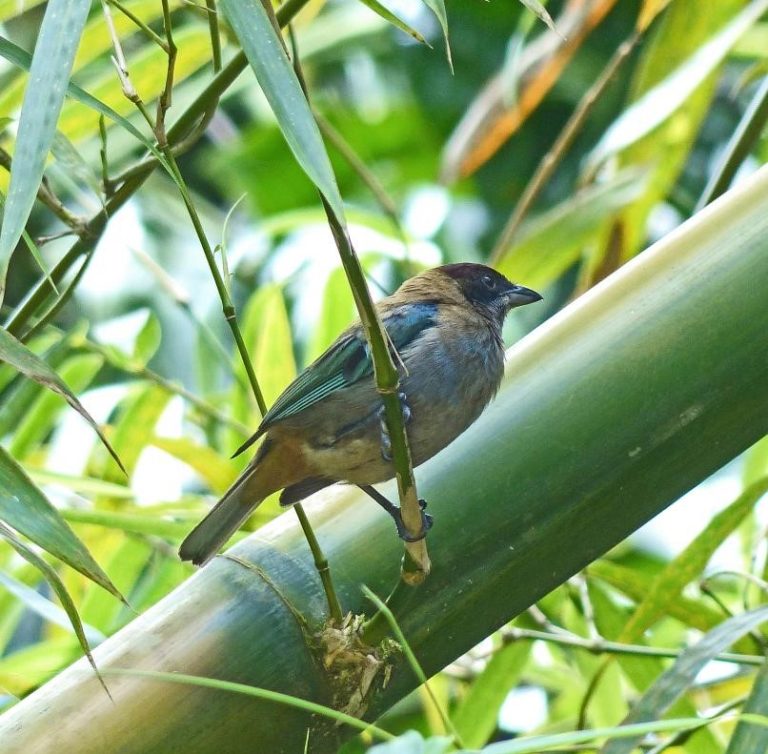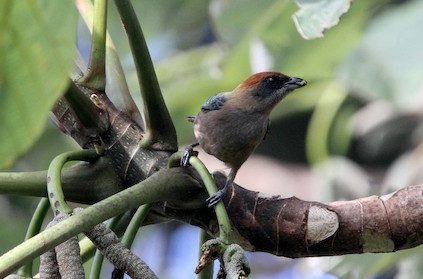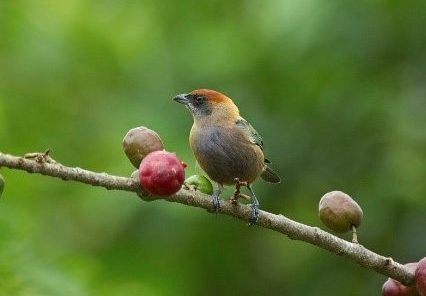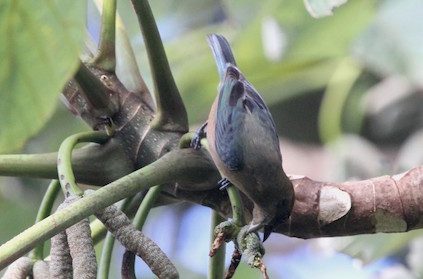Birdfinding.info ⇒ The St. Vincent form of Lesser Antillean Tanager appears to be fairly common in its small range. It can be found consistently along the Vermont Nature Trail and sometimes at Kingstown Botanical Garden.
“St. Vincent Tanager”
Stilpnia cucullata versicolor
Endemic to St. Vincent, where it occurs in forest canopy and woodland edge, including parks and gardens. May also occur regularly in the Grenadines, as it has been reported from Mustique and likely also from Bequia (likely this form, given that Bequia is visible from St. Vincent). (See Frontiers of Taxonomy: Are We Splitting the Lesser Antillean Tanager?)
Identification
Very similar to the “Grenada Tanager”, which likely overlaps with it at least occasionally, and to the Scrub Tanager of western Colombia and Ecuador.
Male is buffy overall with bluish-green wings and tail, a blackish mask and rusty crown.
Females resemble males but the buffy coloration is suffused with a greenish tinge.

“St. Vincent Tanager,” S. c. versicolor. (Kingstown, St. Vincent; June 20, 2013.) © Phil Tizzard

“St. Vincent Tanager,” S. c. versicolor. (Vermont Nature Trail, St. Vincent; February 23, 2014.) © Stephen Gast

“St. Vincent Tanager,” S. c. versicolor. (St. Vincent; May 21, 2018.) © Dan Weedman

“St. Vincent Tanager,” S. c. versicolor. (Vermont Nature Trail, St. Vincent; June 14, 2017.) © Josep del Hoyo

“St. Vincent Tanager,” S. c. versicolor. (Vermont Nature Trail, St. Vincent; February 23, 2014.) © Stephen Gast
Voice. Calls include soft, squeaky, high-pitched twittering:
Vermont Nature Trail, St. Vincent; January 14, 2003. © Linda Macauley
Vermont Nature Trail, St. Vincent; March 7, 2018 (other species also audible). © Brian Sullivan
Cf. “Grenada Tanager”. The two forms—possibly two species—of Lesser Antillean Tanager are very similar, but should usually be separable in the field when both sexes are present. Fortunately, they have a strong tendency to occur in pairs or small flocks. They are usually encountered on their respective islands, St. Vincent and Grenada, but one or both also occur in the Grenadines, which suggests that they sometimes overlap. (Among the Grenadine reports of Lesser Antillean Tanager that are available online, only one is sufficiently detailed to assign to either form: a pair of “St. Vincent Tanagers” on Mustique on November 14, 2009. Other Lesser Antillean Tanager sightings have been reported on eBird from Bequia, Union, and Mayreau, often enough to suggest that one or the other form is routinely present in the Grenadines.)
Males of the two forms are most readily distinguishable by crown color: dark-brown on “Grenada” versus rusty-brown on “St. Vincent”. The color of the wings and tail also tend to differ: paler and greener on “Grenada”; darker and bluer on “St. Vincent”. Both have predominantly buffy upperparts and underparts, but male “Grenada” tends to show a violet wash on the underparts (less often apparent on “St. Vincent”). Apart from the crown, however, the color differences within each form may exceed the differences between them.
Females of the two forms may be indistinguishable if seen singly. Both have rusty-brown crowns and a greenish tinge on their upperparts and underparts. Based on available photographs, female “Grenada” tends to appear brighter and greener overall, including the wings—in other words, female “St. Vincent” has slightly duller, browner body plumage and darker, bluer wings. However, internal variation within each form, along with vagaries of lighting, likely makes the identification of females dubious unless corroborated by the presence of an identifiable male.
Notes
Monotypic form of Lesser Antillean Tanager (T. cucullata) that is regarded by some experts as a separate species. (See Frontiers of Taxonomy: Are We Splitting the Lesser Antillean Tanager?)
References
BirdLife International. 2017. Tangara cucullata (amended version of 2016 assessment). The IUCN Red List of Threatened Species 2017: e.T103848963A119556420. https://dx.doi.org/10.2305/IUCN.UK.2017-3.RLTS.T103848963A119556420.en. (Accessed June 26, 2021.)
BirdLife International. 2017. Tangara versicolor (amended version of 2016 assessment). The IUCN Red List of Threatened Species 2017: e.T103848974A119558904. https://dx.doi.org/10.2305/IUCN.UK.2017-3.RLTS.T103848974A119558904.en. (Accessed June 26, 2021.)
Bond, J. 1979. Birds of the West Indies (Fourth Edition). Collins, London.
del Hoyo, J., N. Collar, and G.M. Kirwan. 2019. Grenada Tanager (Tangara cucullata). In Handbook of the Birds of the World Alive (J. del Hoyo, A. Elliott, J. Sargatal, D.A. Christie, and E. de Juana, eds.). Lynx Edicions, Barcelona. https://www.hbw.com/node/61700. (No longer available. Accessed November 19, 2019.)
del Hoyo, J., N. Collar, and G.M. Kirwan. 2019. St Vincent Tanager (Tangara versicolor). In Handbook of the Birds of the World Alive (J. del Hoyo, A. Elliott, J. Sargatal, D.A. Christie, and E. de Juana, eds.). Lynx Edicions, Barcelona. https://www.hbw.com/node/1344199. (No longer available. Accessed November 19, 2019.)
eBird. 2021. eBird: An online database of bird distribution and abundance. Cornell Lab of Ornithology, Ithaca, N.Y. http://www.ebird.org. (Accessed June 26, 2021.)
Isler, M.L., and P.R. Isler. 1987. The Tanagers: Natural History, Distribution, and Identification. Smithsonian Institution Press, Washington, D.C.
Kirwan, G.M., A. Levesque, M. Oberle, and C.J. Sharpe. 2019. Birds of the West Indies. Lynx Edicions, Barcelona.
Raffaele, H., J. Wiley, O. Garrido, A. Keith, and J. Raffaele. 1998. A Guide to the Birds of the West Indies. Princeton University Press, Princeton, N.J.
